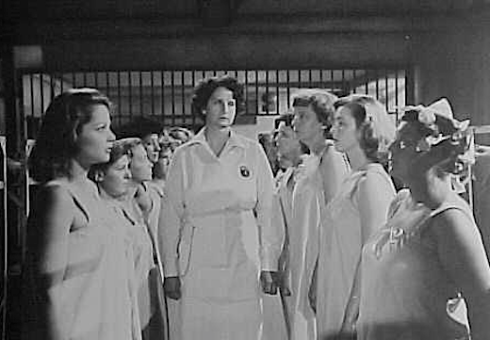Ida Lupino: Actress/Director – The Iron Maiden of Prison Noir
“State’s prison, all prisons look alike from outside, but inside each has a different character. In this one"¦ caged men"¦ separated only by a thick wall. From caged women"¦
The system is wrong but it goes on and on and on"¦”
WOMEN’S PRISON 1955
Directed by Lewis Seller, and written Crane Wilbur, (He Walked By Night 1948, The Bat 1959, House of Wax 1953) with the screenplay and story by Jack DeWitt.
Ida Lupino plays Amelia van Zandt the sadistic borderline, psychotic Warden/Matron of a co-ed women’s prison. She is a total institutionalist, exerting strict regulations, with no gray area for sentimentalism. For van Zandt it’s about the cold hard road to rehabilitation… her way… the hard way.
Lupino has described herself as “the poor man’s Bette Davis.” Ida Lupino moved to Hollywood from England, after filming I Lived with You starring the beautiful Ivor Novello. (The Lodger 1927). She started to make some noise as the hard-edged dame in the 40s, starring in 2 powerful Noir films They Drive by Night (1940) and High Sierra (1941), both starring opposite one of my all-time favorites, Humphrey Bogart.
She starred in two other memorable films which are great contributions to classic Film Noir, Road House 1948 and On Dangerous Ground 1952. For more info about Ida Lupino, the actress, and how she got started as a prolific director of film and television you can read more about her here.
Lupino, while a uniquely beautiful woman, has a face that can convey heartlessness, a hollow shell of a woman, and a militant spinster. ‘The Iron Maiden’, is what I’ve dubbed Lupino for these two particular interchangeable roles.
Women’s Prison is swathed with an ensemble of various Noir Femmes as the rough and weathered inmates. Jan Sterling, Audrey Totter, and Hugo Haas regular Cleo Moore.
There’s also the wonderful Juanita Moore, Vivian Marshall, Mae Clarke, Gertrude Micheal as Chief Matron Sturgess, and one of my favorites, Phyllis Thaxter as the ‘nice girl’ thrust into a ‘bad situation’ who almost loses her mind from the claustrophobic and oppressive iron grip van Zandt keeps on her and the rabid choke hold she keeps on the jugulars of the other female inmates.
And don’t let Thaxter’s role fool you, I’ve seen her play ruthless psychotics in her own right on Boris Karloff’s Thriller episode air date Nov. 6th, 1961Â The Last of The Sommervilles as the conniving sociopath Ursula Sommerville. Interesting connection…Ida Lupino not only wrote the script for the episode but directed it as well!

Although a gritty Noir ‘women in prison film…Â could easily sway into the campy territory, Lewis Seller’s Women’s Prison stays very steady on a course of lensing the social implications of a corrupt and brutal institution that extols credit for keeping the female riff-raff out of the community while perpetuating the hard line, and struggle that many of these women face on the outside. Beating them down, and objectifying them as sexless social misfits who need to be kept away from ‘men’ and out of a ‘decent’ society.
Amelia van Zandt is the hyper-exemplification of what can happen when too much power is given agency and allowed to culminate into a destructive force. van Zandt is the linchpin of brute force, and the submission required in order to control a group or perpetuate an ideal. The fact that she is female illustrates that it does not only have to be a patriarchal institution that can break a women’s spirit. It is here that elements of class and social capital come into focus and play a role in predetermining their fate.
Lupino’s character is similar to Hume Cronyn’s sadistic and unempathetic Capt. Munsey in Jule’s Dassin’s Brilliant Brute Force 1947:

In a way, van Zandt is just another ‘Boogeyman‘ created by an institution that dehumanizes its individuals.
Women’s Prison illustrates what happens when absolute control is given to a person or persons and that control goes unchecked, allowing their private or misguided motivations, mental health, ability to lead, and quite simply the lack of understanding about the human equation to dictate the terms of the human condition in/of an isolated/insulated environment.
Continue reading “Ida Lupino: The Iron Maiden of Prison Noir: Part One ‘Women’s Prison’ (1955)”











































